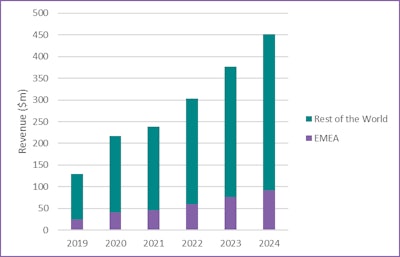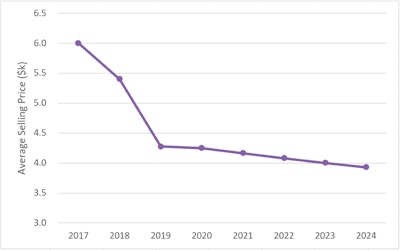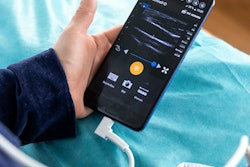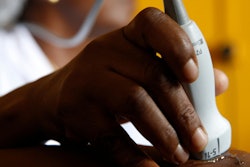
Several factors are spurring the growth of the handheld ultrasound market, and one of the most significant is cost. Until recently, the price of a handheld scanner from a trusted vendor was in the region of $5,000 to $10,000 (4,200-8,400 euros). Now, largely thanks to the impact of Butterfly Network and its stated aim of democratizing medical imaging, scanners can be picked up for as little as $2,000 (1,700 euros).
The combination of improved imaging performance, clinical utility, and a lower price has expanded ultrasound's market opportunity beyond hospital departments to also include clinical specialists. For a very modest outlay, a primary care physician can equip a surgical suite with an useful piece of equipment. This scenario is predicted to be the biggest mid- to long-term growth driver for handheld ultrasound.
Overall, the market is set for rapid growth, as shown in the graph below.
 EMEA = Europe, Middle East, and Africa.
EMEA = Europe, Middle East, and Africa.Source: Ultrasound Equipment -- World Market Report, 2020, Signify Research.
The COVID-19 pandemic has increased demand for handheld ultrasound massively in 2020, with the technology becoming a front-line diagnostic tool for patients with suspected COVID-19. The availability of affordable and fit-for-purpose handheld scanners has helped hospitals to deal with more patients more quickly -- a crucial factor in an exponentially growing pandemic.
Handheld ultrasound scanners, especially wireless versions, are easier to disinfect than traditional cart-based systems and other imaging modalities, and infected patients don't have to move through hospitals to imaging departments, raising the risk of spreading infection.
The importance of COVID-19 is likely to diminish as a driver of adoption of handheld ultrasound as the worst effects of the pandemic (hopefully) continue to lessen, but COVID-19 might also have a longer-term impact on the market in other, less direct ways.
Working from home
The pandemic and the subsequent lockdown measures enforced by many of the world's governments have forced people to do at home what was thought only possible in specifically designed places. In the worst-hit areas of Italy, the home started to become a work environment in other ways, enabled in part by the growing availability of handheld ultrasound systems. In these areas, people were being scanned in their homes.
This is just the latest example of a trend which -- although in its infancy -- has been steadily gathering pace for several years. Ultrasound is making the jump from a clinical to a domestic setting due to companies offering the hire of ultrasound machines for the home. Netherlands-based Babywatcher, for example, promises that in conducting a scan, expectant mothers can, "sit back, light the candles and experience the ultimate pregnancy happiness" with the hire of an ultrasound machine being positioned as a perfect pregnancy gift.
Baby-Scan, meanwhile, suggests pregnant women buy its Baby-Scan Baby-Scanner to "take fun scans at home." Medical devices are being offered as consumer items. Even the Butterfly IQ, a professional medical device that includes a warning that it should only be used by qualified practitioners, still features branding and marketing material more reminiscent of a Silicon Valley smartphone than a diagnostic device.
The distinction between serious medical technology and consumer technology was blurred even more when PulseNmore launched in the summer of 2020. The Israeli firm's device is an ultrasound transducer that docks with a smartphone, and it would look right at home alongside the electric toothbrushes, personal wellness devices, and electric shavers that fill people's bathroom cabinets. In addition to "enhancing the pregnancy experience," the scanner will help pregnant women "know about the well-being of their baby," according to Lior Wolff, the head of translational innovation at Clalit Health Services, which is distributing the device.
In just a few years, ultrasound has gone from being a clinical tool to be used in a clinical setting by clinicians to being a technology that can, in theory at least, be used by anyone, anywhere, at any time.
Ultrafreedom
Novice users are being empowered to use a tool in several ways that, to this day, many primary care physicians can't. First, most handheld scanners come with built-in presets that can be used to quickly garner key measurements. A heart's ejection fraction or the estimated due date of a fetus, for example, can be automatically calculated by the system's tools.
Another enabler is teleultrasound, in which live ultrasound images are transmitted through teleconferencing to experts to guide novice users. Interest in teleultrasound has been heightened during the COVID-19 pandemic and facilitated by the U.S. Food and Drug Administration's emergency use authorization, which has enabled many in the medical field to use ultrasound where they wouldn't have otherwise.
In addition to a typical teleultrasound offering, in which a trained professional can remotely see the scan and talk to an untrained professional through the process, Butterfly Network has also added an augmented reality tool that superimposes arrows on a user's smartphone to visually guide the novice to ensure the scanner itself is positioned correctly.
Artificial intelligence (AI) will also play a key part in assisting novices to use ultrasound, both in terms of AI-enabled image capture assistance alongside automated anatomy navigation. Furthermore, AI can also compare the acquired image to standardized criteria to ensure that it meets clinical standards.
The first example of the latter is GE's Voluson Swift system, which incorporates Intelligent Ultrasound's ScanNav Assist AI technology. While currently only available on more expensive cart-based systems, it is only a matter of time before this capability cascades down to handhelds.
Finally, in what is perhaps the most "consumeresque" aid of all, vendors have released simple-to-understand YouTube tutorials. Users can learn how to position the Butterfly IQ scanner and find out what is displayed on the smartphone screen, which settings to press, and what to look for on the scan itself.
These developments, combined with need to keep people away from hospitals whenever possible during the pandemic, means that it is increasingly likely that more ultrasound scans are set to be conducted at home. Initially, professionals will be responsible, but for people with certain conditions that require regular scans, it might prove safer, more efficient, and cheaper in the long-term for people at home to be given a handheld unit and basic training and then left to scan themselves at a given frequency, with the images going directly to a doctor.
Further in the future, it is easy to imagine consumers buying scanners themselves, particularly as costs come down and AI-powered instructional software gets better.
What's the downside?
There are risks of handhelds being used by nonexperts, and potential inaccuracy is a serious problem. A medical professional has a wealth of knowledge and experience with which he or she can scrutinize a dubious result. Novice users lack this expertise, and they are therefore susceptible to drawing incorrect conclusions.
This would no doubt also be an issue with ultrasound scanners at home. Women could purchase a scanner to see their unborn babies, and lacking any knowledge other than that shared on the scanner's YouTube channel, they could find the heartbeat and assume everything is fine but miss another indicator of ill health that an expert would pick up. This could be especially prevalent if people depend on the current crop of AI diagnostic tools that are blind to conditions they haven't been specifically developed to detect.
Conversely, the opposite could also be a problem. Imagine the influx of people into emergency rooms if they had a live image of their heart, lungs, or bladder to misread. Panic may occur if people think they have found a shadow on the lung or if they struggle to find a baby's heartbeat.
It seems inevitable that for every legitimate catch, there are going to be many misdiagnoses, sending thousands of people to hospitals and clinics and placing even greater demands on the time of already overstretched clinicians.
Falling prices
The prevalence of many of these issues will depend on how ultrasound scanners make their way into people's homes. After all, if a scanner is prescribed by a medical specialist who carefully explains the technology and its limitations, it will be thought of very differently than if it is picked up from a supermarket.
The reality, however, is that falling prices make handheld scanners more accessible, as shown in the graph below.

Cost will play a big part in deciding the future of the technology. A price tag of $2,000 (1,700 euros) might seem cheap to medical professionals, but it's still an issue for most potential customers. The first successful "ultrasound at home" company is likely to be the one that makes it affordable to the mass market.
But, the costs of the devices themselves will, at least in the foreseeable future, only be able to fall to a certain price. Regardless of their ubiquity, they will always be precision medical devices with associated costs like calibration and quality assurance that will never be able to be completely nullified, regardless of production efficiencies. So in all likelihood, this means either a subscription model or as part of a broader health service, perhaps from an insurer, rather than an outright purchase, will be what takes handheld ultrasound mainstream.
This is a good thing. It would bring the cost down to a manageable level for lots of households, getting the devices to people that could benefit from them, but it would also mean that consumers were signing up for a service and not just hardware. It would give them a place to go not only for support during the scan itself but also with their concerns and their homemade diagnoses. A health plan member could conduct their monthly scan, and, if they saw something unusual, flag it for review (perhaps for a small fee), whereupon it would be assessed by a professional, who could then refer the customer to a supported provider.
From a business side, this would also help the vendors. Instead of growth coming from ever-greater volume, at ever-lower margins as competition in the market increases, an ultrasound at-home subscription service means predictable ongoing revenue and the ability to scale at a more granular pace. Instead of building a new manufacturing hub based on optimistic sales forecasts, investment could be made with the certainty of sticky and repeatable subscription revenues already in the books.
Another avenue for collecting revenue for handheld vendors is an app-store option. If a subscription can get the devices in enough hands, it becomes viable for software developers to offer very specific tools. Consumers at home could have a primary reason for having an ultrasound machine, but if they had a sports injury, for example, they could spend a small amount on downloading an AI app to assess it, with the vendor taking a cut.
Sound outlook
There is still a long way to go before people performing their own ultrasound scans at home is as common as them taking their blood pressure or temperature, but the trend is real. Decentralization is happening, ultrasound has moved from dedicated hospital units to primary care centers and is making its way to people's houses via COVID-19-catalyzed health visits.
How this trend develops is reliant on vendors being able to make their products affordable to customers, yet still profitable for themselves. It will also require careful consideration given the implications and repercussions of allowing a professional tool out in the wild.
In the longer term, these considerations, along with the growing adoption of telehealth services (see Signify Research's Telehealth (Acute, Community, and Home) -- World 2020 report for more information) will mean a shift toward teleultrasound services, in which customers will eventually receive scanners for free as part of a comprehensive ultrasound subscription service, much like today's smartphone business model, with profits made from teleultrasound services and app sales.
Cost is still a barrier to increased adoption. But as that falls, it will just take one vendor, one provider, one insurer, just one company with a novel strategy to strike on the right model, which is both helpful and lucrative, before the floodgates open and ultrasound at home is an everyday occurrence.
Simon Harris is managing director and principal analyst, and Alan Stoddart is editor, both at Signify Research, a health technology market intelligence firm based in Cranfield, U.K.
The comments and observations expressed do not necessarily reflect the opinions of Auntminnie.com or AuntMinnieEurope.com, nor should they be construed as an endorsement or admonishment of any particular vendor, analyst, industry consultant, or consulting group.
Copyright 2020 © Signify Research



















